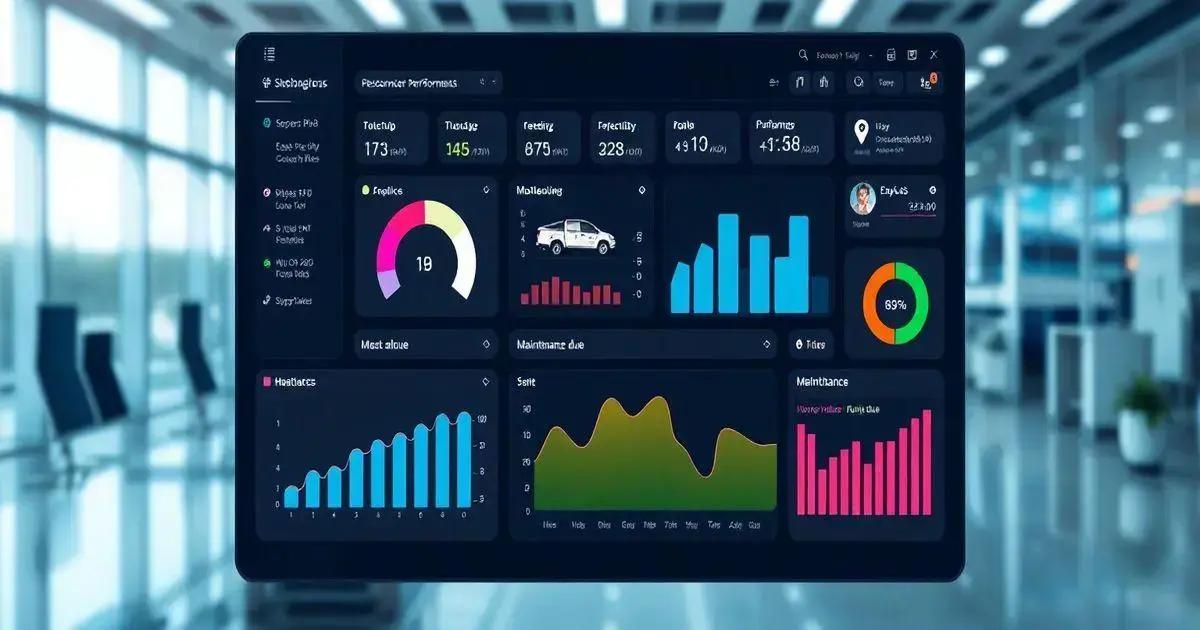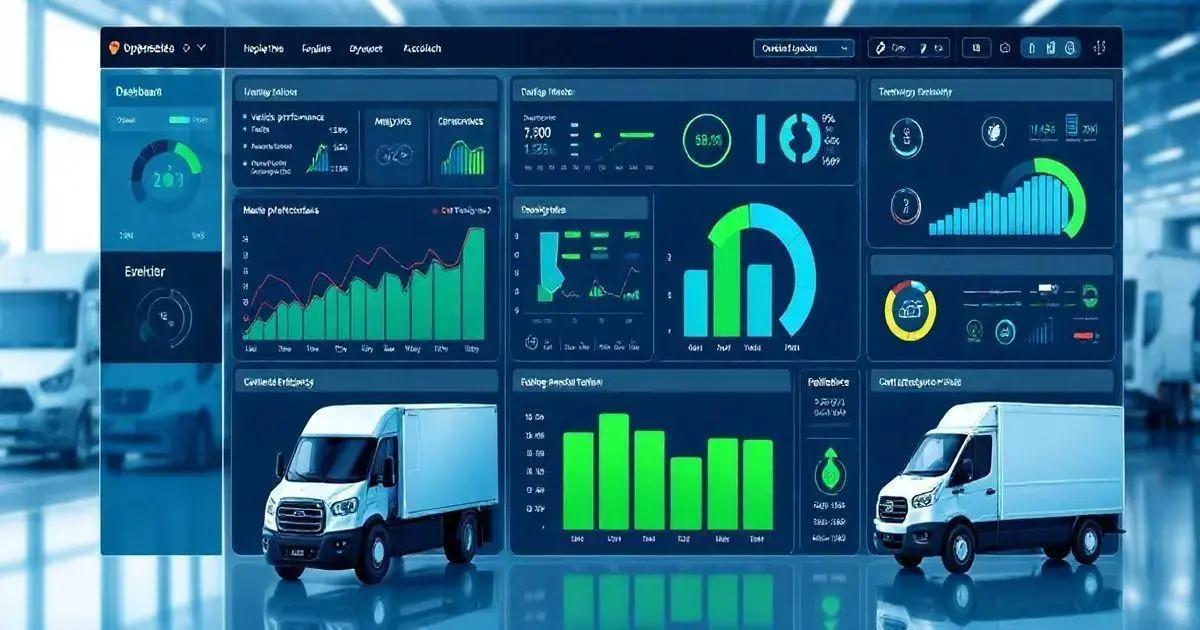Top 5 Features of Fleet Control Worksheet 7.0 You Need Leave a comment
The Fleet Control Worksheet 7.0 is an advanced fleet management tool that enhances operational efficiency by providing features such as an initial dashboard for tracking key metrics, document management for compliance, detailed travel logs for expense tracking, and preventive maintenance scheduling, ultimately improving safety and resource allocation for businesses.
The Fleet Control Worksheet 7.0 is a powerful tool designed for businesses looking to streamline their fleet management processes. With features such as detailed dashboards and maintenance tracking, this spreadsheet template can significantly enhance operational efficiency.
In this article, we will explore the top features of the Fleet Control Worksheet 7.0, demonstrating how it can help you manage your fleet effectively.
Key Features of Fleet Control Worksheet 7.0
The Fleet Control Worksheet 7.0 is packed with features that cater to various aspects of fleet management, ensuring that businesses can operate smoothly and efficiently. Here are some of the key features:
Key Features of Fleet Control Worksheet 7.0
- Comprehensive Dashboard: The worksheet comes with an initial dashboard that provides insights into key metrics like kilometers driven per driver, average fuel consumption, and overall vehicle performance. This feature allows fleet managers to quickly assess the health of their fleet at a glance.
- Travel and Cargo Control: Track all trips and associated cargo efficiently. The worksheet includes sections for entering travel details, cargo specifics, and expenses related to each trip, ensuring that all information is documented in one place.
- Tire Management: The tire control section allows for tracking tire changes, schedules, and remaining kilometers before a tire needs to be replaced. This proactive approach helps in maintaining tire health and performance.
- Document Management: The worksheet facilitates easy management of important documents for both vehicles and drivers. Users can track the status of licenses, insurance, and maintenance records, ensuring compliance and reducing the risk of penalties.
- Maintenance Tracking: Keep records of both preventive and corrective maintenance activities. This feature helps in scheduling maintenance tasks and monitoring maintenance costs, ensuring that vehicles are always in optimal condition.
These features make the Fleet Control Worksheet 7.0 an invaluable tool for businesses aiming to optimize their fleet operations. By leveraging these functionalities, companies can reduce costs, enhance productivity, and improve overall fleet management efficiency.

Initial Dashboards Overview
The Fleet Control Worksheet 7.0 features an intuitive and comprehensive initial dashboard that serves as the command center for your fleet management activities. This dashboard is designed to present critical data points in a clear, visually appealing format, making it easy for fleet managers to grasp the current status of their fleet at a glance.
Here are some key components included in the initial dashboards:
- Kilometers by Driver: This section displays the total kilometers driven by each driver, enabling managers to monitor driving patterns and performance effectively.
- Kilometers per Vehicle: Track the distance traveled by each vehicle in the fleet. This data is crucial for evaluating vehicle usage and identifying those that may require maintenance.
- Kilometers per Liter: This metric helps assess fuel efficiency, showcasing how many kilometers are driven per liter of fuel. It is essential for managing fuel costs and optimizing fuel consumption.
- KM per Trip: Understanding the average distance per trip can aid in route optimization and planning, leading to reduced operational costs.
- Average Consumption per Vehicle: This feature provides insights into the average fuel consumption for each vehicle, helping identify those that may be underperforming or need servicing.
Overall, the initial dashboard of the Fleet Control Worksheet 7.0 integrates vital metrics into a single view, allowing for quick decision-making and enhancing the overall management of fleet operations. By utilizing these insights, fleet managers can not only monitor performance but also make informed adjustments to improve efficiency and reduce costs.
Vehicle and Driver Document Management
Effective management of vehicle and driver documentation is crucial for compliance and smooth operations in any fleet management system. The Fleet Control Worksheet 7.0 offers a dedicated section for handling all necessary documentation, ensuring that all records are organized, up-to-date, and easily accessible.
Here are the key features of the Vehicle and Driver Document Management section:
- Driver Document Control: This feature allows fleet managers to track important documents for each driver, including licenses, certifications, and health checks. By maintaining this information in one place, managers can ensure that all drivers are compliant with legal requirements and ready for duty.
- Vehicle Document Control: Similar to driver documents, this section keeps track of each vehicle’s registration, insurance, and maintenance records. Having all vehicle documents organized helps in avoiding fines and penalties that can arise from expired paperwork.
- Alerts and Notifications: The worksheet can be set up to provide alerts for upcoming document expirations, ensuring that managers are always aware of which documents need to be renewed. This proactive approach helps in maintaining compliance and reducing downtime.
- Easy Access and Updates: Users can quickly add or update documentation as needed, ensuring that all records reflect the most current information. This minimizes the risk of errors and enhances accountability.
- Comprehensive Reporting: The document management section can generate reports on document status, helping managers assess compliance at a glance. This reporting feature can also assist in audits and inspections.
By leveraging the Vehicle and Driver Document Management features of the Fleet Control Worksheet 7.0, fleet managers can significantly enhance their operational efficiency while ensuring compliance with regulations. This structured approach not only simplifies the management process but also contributes to safer and more responsible fleet operations.
![]()
Travel Control and Expense Tracking
The Fleet Control Worksheet 7.0 includes a robust system for managing travel details and tracking associated expenses, essential for maintaining financial oversight and operational efficiency. This section is designed to streamline the process of recording and analyzing travel-related costs, providing fleet managers with valuable insights into spending patterns.
Here are the key features of the Travel Control and Expense Tracking section:
- Comprehensive Travel Log: Users can enter detailed information for each trip, including departure and arrival times, destinations, cargo details, and the vehicles used. This log allows for thorough tracking of all travel activities within the fleet.
- Linked Cargo Control: The travel section is integrated with cargo management, allowing users to link specific trips to the cargo being transported. This facilitates effective load management and enhances accountability for cargo handling.
- Expense Recording: Managers can easily input expenses related to each trip, such as fuel costs, tolls, maintenance, and other operational expenses. Having all costs associated with travel documented in one place aids in budget tracking and financial analysis.
- Cost Summary Reports: The worksheet generates summary reports that provide insights into total travel costs, fuel consumption, and other expenses. This feature allows managers to quickly analyze spending and identify areas for cost optimization.
- Comparison and Analysis: Users can compare travel expenses against budgets and previous trips, providing a clear picture of how spending aligns with organizational goals. This analysis helps in making informed decisions regarding route planning and operational adjustments.
By utilizing the Travel Control and Expense Tracking features in the Fleet Control Worksheet 7.0, fleet managers can gain a comprehensive understanding of travel costs and optimize fleet operations accordingly. This transparency not only aids in budgeting but also enhances overall financial management within the organization.
Preventive Maintenance and Tire Control
Maintaining a fleet’s vehicles in optimal condition is vital for ensuring safety, efficiency, and longevity.
Preventive Maintenance and Tire Control
The Fleet Control Worksheet 7.0 offers comprehensive features for managing preventive maintenance and tire control, which are crucial for reducing downtime and minimizing repair costs.
Here are the key features of the Preventive Maintenance and Tire Control section:
- Scheduled Maintenance Tracking: The worksheet allows fleet managers to set up schedules for preventive maintenance tasks, such as oil changes, brake inspections, and other routine checks. By documenting and scheduling these tasks, businesses can reduce the risk of unexpected breakdowns and extend the lifespan of their vehicles.
- Maintenance History Logs: Managers can easily record all maintenance activities performed on each vehicle, creating a detailed history that can be referenced for future maintenance decisions. This log is invaluable for tracking vehicle performance and identifying recurring issues.
- Tire Management System: Tire control features enable users to track the lifespan and performance of each tire within the fleet. This includes registering tire changes, monitoring tread depth, and scheduling rotations based on mileage, ensuring that tires are replaced proactively rather than reactively.
- Kilometers to Tire Change Notifications: The worksheet calculates and alerts users when tires are nearing their replacement threshold based on accumulated kilometers. This foresight helps prevent tire-related incidents and ensures safety on the road.
- Cost Analysis of Maintenance: Users can analyze the costs associated with preventive maintenance and tire management over time. This feature helps in budgeting and understanding the financial impact of maintenance practices on overall fleet operations.
By implementing the Preventive Maintenance and Tire Control features of the Fleet Control Worksheet 7.0, fleet managers can ensure that their vehicles remain safe, efficient, and reliable. This proactive approach not only minimizes costs associated with repairs but also enhances the overall productivity of fleet operations.
Conclusion
In summary, the Fleet Control Worksheet 7.0 is an essential tool for businesses looking to enhance their fleet management practices.
With its comprehensive features for document management, travel control, expense tracking, preventive maintenance, and tire control, this worksheet provides a thorough approach to overseeing fleet operations.
By utilizing the powerful dashboards and detailed logging capabilities, fleet managers can make informed decisions that improve efficiency, reduce costs, and ensure compliance with regulations.
The proactive maintenance and tire control features specifically help extend the life of vehicles and enhance safety on the roads.
Investing in the Fleet Control Worksheet 7.0 not only optimizes day-to-day operations but also sets the foundation for long-term success in fleet management.
For any organization aiming to streamline their processes and achieve better financial outcomes, this tool is a game changer.
FAQ – Frequently Asked Questions about Fleet Control Worksheet 7.0
What is the Fleet Control Worksheet 7.0?
The Fleet Control Worksheet 7.0 is a comprehensive spreadsheet template designed to help businesses manage their fleet operations, including tracking vehicle maintenance, driver documentation, travel expenses, and more.
How does the document management feature work?
The document management feature allows users to track and manage important documents for both vehicles and drivers, ensuring compliance with legal requirements and easy access to critical information.
Can I track expenses related to each trip?
Yes, the worksheet includes features for recording and tracking expenses associated with each trip, allowing for better budget management and financial oversight.
What kind of maintenance tracking does the worksheet provide?
The worksheet allows users to schedule and track preventive maintenance tasks, log maintenance history, and receive notifications for upcoming maintenance needs to reduce downtime.
Is tire management included in the features?
Absolutely! The Fleet Control Worksheet 7.0 has a dedicated tire management section that tracks tire changes, schedules, and provides alerts for when tires need to be replaced.
How can I analyze the costs associated with maintenance?
The worksheet offers reporting features that allow users to analyze maintenance costs over time, helping to identify spending patterns and optimize budget allocation.

